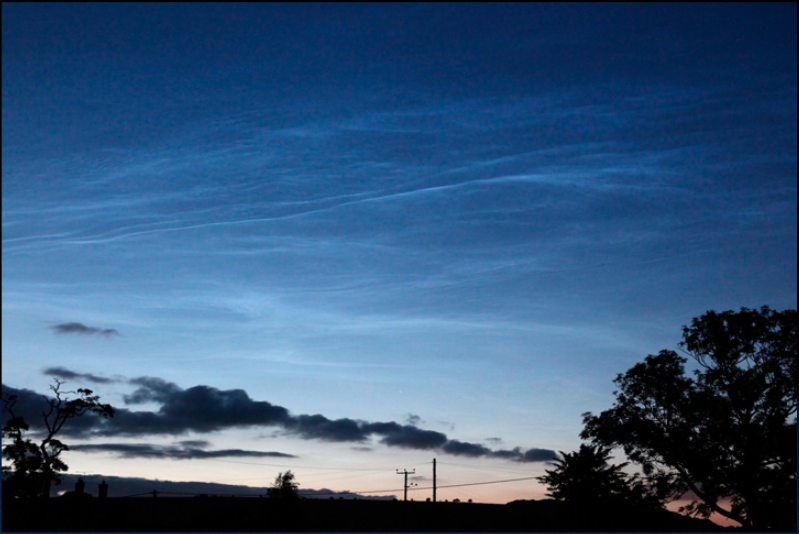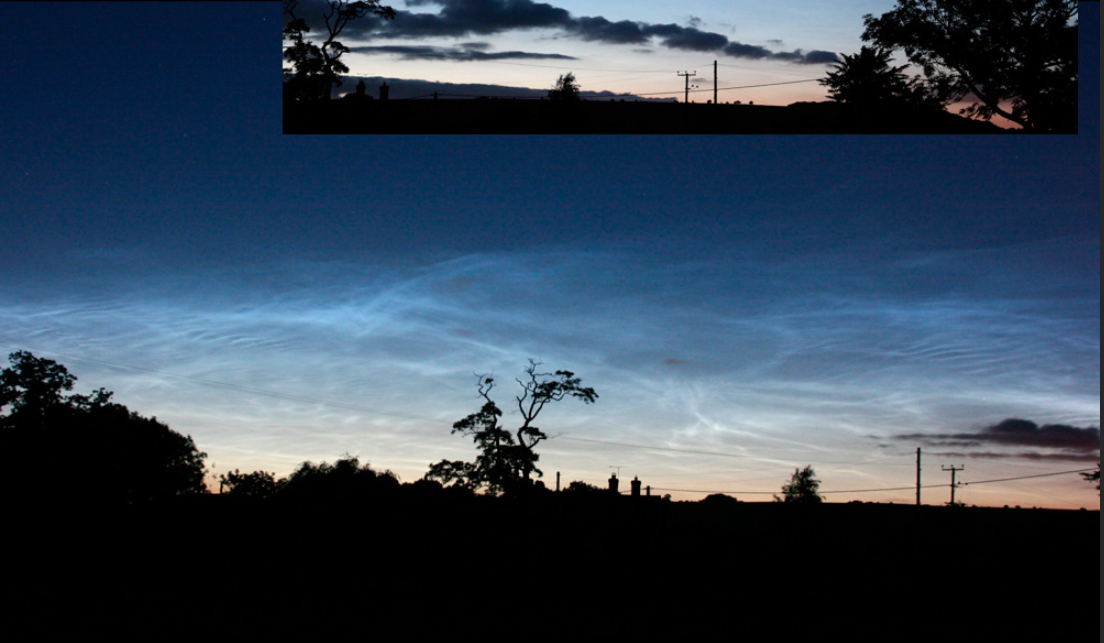More NLCs!
More Noctilucent Clouds (NLCs)!
Noctilucent clouds, also known as NLCs, are a fascinating atmospheric phenomenon that occurs in the mesosphere, the third layer of the Earth's atmosphere. These ethereal clouds, which are composed of ice crystals, can only be seen during twilight hours when the sun is below the horizon but still illuminates the sky. In recent times, there has been an increase in NLC sightings, captivating skywatchers around the world.
During the nights of July 9th and 10th, NLC displays were observed over a wide area of Europe, capturing the attention of both amateur and professional photographers. One such observer, Paul Money from Lincolnshire, England, managed to capture a striking image of these clouds. The photograph revealed a bright "knot" of NLCs, intensely radiant against the still light twilit sky. From a distance of 35 miles to the southeast, these clouds appeared to be situated at an altitude of 20-25 degrees, extending from the northwest to the northeast.
At first glance, these clouds seemed unusually bright for NLCs. However, upon closer inspection through binoculars, Paul Money noticed the presence of darker and faster-moving lower clouds, along with the intricate fine structure of the NLCs. As the evening progressed, the NLCs gradually descended in the northwestern direction, adding a sense of dynamism to the spectacle.
Richard Fleet from Wiltshire, England also captured images of NLC displays a few days prior to Paul Money's observation. These photographs provided further evidence of the widespread occurrence of NLCs across Europe during this period. The mesospheric clouds, located approximately 50 miles above the Earth's surface, were a sight to behold.
The increase in NLC sightings in recent times has sparked curiosity among scientists and sky enthusiasts alike. While the exact reasons behind this surge are not yet fully understood, there are several factors that could contribute to the more frequent appearance of NLCs:
-
Climate Change: Changes in temperature and humidity patterns in the upper atmosphere could create conditions favorable for the formation of NLCs.
-
Increased Observations: With advancements in technology and the growing interest in skywatching, more people are actively looking for and documenting NLC sightings, leading to an apparent increase in reported occurrences.
-
Improved Awareness: The internet and social media platforms have provided a platform for individuals to share their NLC sightings with a wider audience, creating a sense of excitement and encouraging others to keep an eye out for these captivating clouds.
Despite the increase in NLC sightings, it is important to note that these clouds are still relatively rare compared to other cloud types. They typically occur at high latitudes, closer to the poles, although there have been instances of NLCs being observed at lower latitudes in recent years.
Studying NLCs provides valuable insights into the dynamics of our atmosphere and the delicate balance of its various layers. Scientists continue to monitor and analyze these unique clouds to better understand their formation mechanisms and potential connections to climate change.
As the interest in NLCs grows, it is essential for both amateur and professional skywatchers to contribute their observations to scientific databases. By doing so, we can collectively enhance our understanding of this mesmerizing atmospheric phenomenon and unravel the mysteries hidden within our skies. So keep your eyes on the horizon during twilight hours, and who knows, you might be lucky enough to witness the captivating beauty of Noctilucent clouds yourself!

Europe's NLCs - 9/10 July
Paul Money (Astrospace) caught the top image from Lincolnshire, England. The bright 'knot' was intensely bright. At 2200 UT from 35 miles to the SE I saw these clouds 20-25� high and extending from the NW to NE. In the still light twilit sky they seemed much too bright for NLCs but the presence of darker faster moving lower clouds and their fine structure seen through binoculars convinced me. As the evening progressed the clouds slowly sank in the north west.
The lower images are from Wiltshire, England. Richard Fleet ( Glows Bows & Haloes ) took them. He captured an earlier display a few days previously.
The 50 mile high mesospheric clouds were seen over a wide area of Europe.
©the photographers, shown with permission.


Note: this article has been automatically converted from the old site and may not appear as intended. You can find the original article here.
Reference Atmospheric Optics
If you use any of the definitions, information, or data presented on Atmospheric Optics, please copy the link or reference below to properly credit us as the reference source. Thank you!
-
<a href="https://atoptics.co.uk/blog/more-nlcs/">More NLCs!</a>
-
"More NLCs!". Atmospheric Optics. Accessed on November 26, 2024. https://atoptics.co.uk/blog/more-nlcs/.
-
"More NLCs!". Atmospheric Optics, https://atoptics.co.uk/blog/more-nlcs/. Accessed 26 November, 2024
-
More NLCs!. Atmospheric Optics. Retrieved from https://atoptics.co.uk/blog/more-nlcs/.